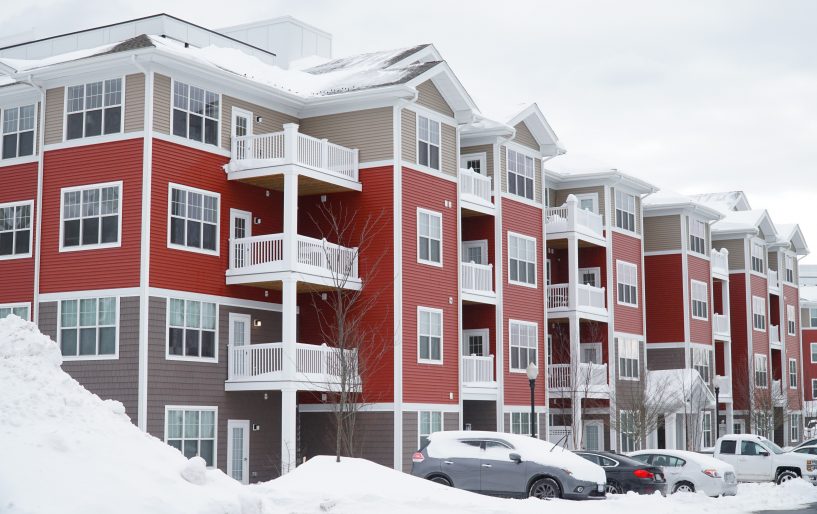With experts predicting an early start to Canada’s cold season, the time to get started on winter maintenance is now. We’ve all heard that the best defense is a good offense; well, the same concept applies to winter-proofing apartment buildings. Having a business continuity plan and preventative measures in place is not only good practice, but it can also significantly decrease expensive and overwhelming insurance claims.
The key is to remember how winter impacts people’s homes and lives. Specific considerations need to be made for apartment buildings given residents are relying on their management team to ensure certain safety steps are in place. Being prepared can help mitigate cold-related risks such as flooding and slip and falls, while also helping to reduce the risk of costly litigation.
Overcoming common pitfalls
Experienced facility managers understand that things won’t always go as planned, especially when weather is involved. However, there are a few common pitfalls managers should be aware of to help them prepare for any issues that may arise.
Relying on an undefined or unclear set of plans or systems is the best way to be caught by surprise. Not having a preparedness plan or not identifying the risks a building faces can have costly consequences. Conducting a full risk-assessment of the building with the goal of identifying potential issues is a start. Creating procedures to follow in case of emergency or weather-related disasters can be the turning point in ensuring an issue doesn’t become a crisis.
Another stumbling block is not having a good understanding of your building’s infrastructure. Winter can be harsh on the infrastructure of apartment buildings. Important questions abound: do you know where the shutoff valves are?
By being aware of risks, maintenance issues and repairs, managers can protect properties through the shifting seasons and keep residents happy and safe.
Be proactive
Facilities managers can be under increasing pressure to avoid unnecessary expenses and do more to operate efficiently. That’s why implementing a proactive winter maintenance strategy is critical for capturing cost savings while instilling trust and confidence in residents. A proactive plan requires not only understanding the current infrastructure but the existing and projected needs of the building.
The following tips can help managers keep their properties in good working order, reduce costs and mitigate situations, so they’re not left out in the cold:
- Inspect roof space and clear debris. Clear your building’s roof space of leaves and anything that can cause blockage of roof drains and gutters as this can impede the proper flow of melting snow away from the building. Ensure you keep two metres away from the edge of the roof and only clean up debris if it can be done safely.
- Routinely check property during cold periods. Check your commercial spaces regularly during the winter months. Make sure stairwell doors are closed as cold air can cause hydronic heating lines to freeze and burst.
- Beware of moisture and mould buildup. Ice and snow can quickly turn to water that seeps through foundations and cause mould which can lead to extensive damage and health risks. Always inspect for any visible cracks and ensure foundations are sealed.
- Check furnaces. Ensure filters are in good condition and that the furnace is working efficiently and properly to avoid expensive repairs or unwanted heating interruptions. Your HVAC provider should complete maintenance in advance of cold weather and ensure boilers are working optimally.
- Check alarms. Check carbon monoxide and smoke alarms. During the winter, people stay indoors longer and increased use of heaters can lead to risks of fire and carbon monoxide poisoning.
- Avoid frozen pipes and plumbing issues. Compromised pipes and water management systems can be a messy or catastrophic situation if not adequately cared for. Winter plumbing and water issues tend to take place in batches and impact multiple units at once. Water issues are expensive in general, but when they affect multiple units, they can be astronomically costly.
- Regularly check for exposed sprinkler lines to ensure they are either properly insulated or have heat trace cables to prevent them from freezing. Ensure isolation valves that supply water have been closed and that snow melt systems that use glycol are serviced and working properly.
Finally, trying to find leaks in multi-residential buildings is not always easy. By installing leak detection technology, abnormal water flows can be detected and alerted to management. Installing leak detection systems in buildings also allows building managers to analyze usage patterns and identify methods to reduce water consumption which can help with sustainability goals.
In the depths of winter, we learn that nothing burns like the cold. Buildings have continuous issues, but through proactive winter maintenance strategies, apartment managers can take steps to keep residents and infrastructure safe and resilient no matter what the season brings.
 Craig Smith is Director, Commercial Business Development, First Onsite Property Restoration
Craig Smith is Director, Commercial Business Development, First Onsite Property Restoration






